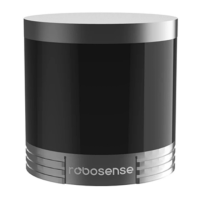What to do if RoboSense Robotics LiDAR rotates but there is no data output?
- BbeckerericaAug 16, 2025
If your RoboSense Robotics LiDAR is rotating but not outputting data, try the following: * Ensure the network connection is stable. * Verify that your computer's network configuration is correct. * Use software like Wireshark to check if the packet output is normal. * Disable firewalls and security software that might be blocking the network. * Confirm the power supply is working correctly. * Restart the sensor.


